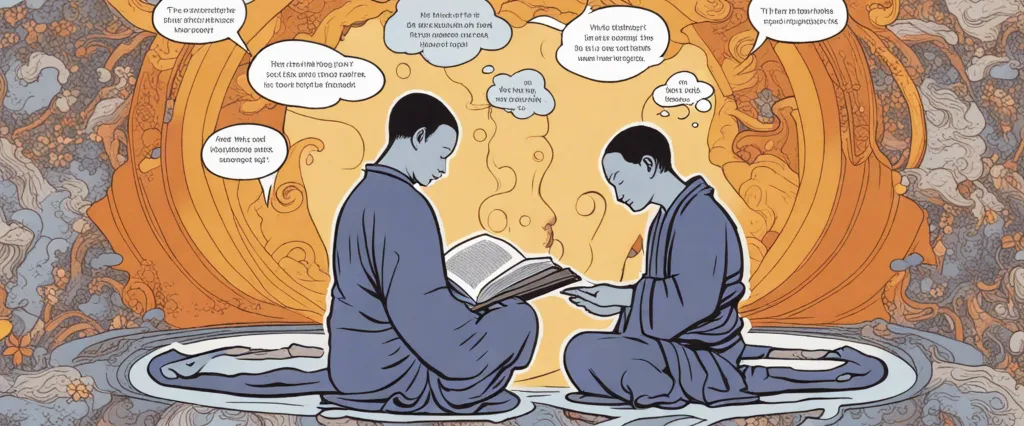——Why Buddhism is True by Robert Wright & The Blank Slate by Steven Pinker

Human beings have long sought answers to existential questions about the nature of reality, consciousness, and the human condition. In this comparative study, we delve into the transformative realms of two thought-provoking books: “Why Buddhism is True” by Robert Wright and “The Blank Slate” by Steven Pinker. While seemingly divergent in subject matter, both works explore fundamental aspects of human cognition, behavior, and the quest for understanding.
Wright’s “Why Buddhism is True” delves into the deep and intricately interconnected realms of Buddhist philosophy and practices, proposing a harmonious convergence with modern scientific understanding. Contrasting this, Pinker’s “The Blank Slate” explores the concept of human nature and challenges the popular notion of a “blank slate” upon which society imprints its ideas, beliefs, and values. Despite seemingly different focal points, both authors share a common objective – to empower readers with a better understanding of our humanness and the truths that govern our perception of the world.
In “Why Buddhism is True,” Robert Wright scrutinizes the teachings of Buddhism through a scientific lens, exploring how the ancient wisdom of meditation, mindfulness, and introspection aligns with contemporary scientific discoveries about human cognition and emotions. Wright posits that understanding the mechanisms underlying human thought processes and urges in light of evolutionary psychology can help unlock the truths encapsulated within Buddhist teachings, offering a pathway to personal fulfillment and collective harmony.
Meanwhile, Steven Pinker’s “The Blank Slate” counters the notion that human cognition is born as a blank slate, free from innate predispositions or genetic influences. As a renowned cognitive psychologist, Pinker dismantles the widely-held belief in a completely malleable human nature, illustrating the impact of evolutionary forces on our behavior, language acquisition, moral values, and social hierarchies. Through his exploration of neuroscience, genetics, and evolutionary biology, Pinker invites readers to reevaluate traditional assumptions about human nature and its implications for societal progress.
Within this comparative study, we aim to analyze and synthesize the key arguments and insights put forth by both Wright and Pinker. Despite divergent subject matters, their works converge in presenting a holistic understanding of human cognition, behavior, and the quest for self-discovery. By juxtaposing these seemingly disparate works, we uncover intriguing parallels that invite further exploration and discussion.
In the subsequent sections, we will critically examine the points of intersection and departure between the approaches and arguments presented by Wright and Pinker. Drawing on various disciplines, such as cognitive science, evolutionary psychology, and philosophy, we will illuminate the congruences and divergences in their respective quests for truth. Additionally, we seek to highlight the implications of their theories on our understanding of human nature and its role in fostering personal well-being and societal harmony.
Through this comparative study, we hope to shed light on the profound insights offered by “Why Buddhism is True” and “The Blank Slate,” fostering a deeper appreciation for the complexities of human nature and its profound influence on our individual and collective journeys. Join us as we embark upon an intellectual voyage, exploring the intersections between ancient wisdom and modern science, and uncovering the threads that weave our shared understanding of what it means to be human.
Brief Summary of Two Books
Why Buddhism is True by Robert Wright
“Why Buddhism is True” by Robert Wright is a thought-provoking exploration of how Buddhist teachings align with modern scientific understanding of the human mind and the nature of reality. The book attempts to bridge the gap between psychology, biology, and Buddhism by examining various aspects of human behavior such as emotions, consciousness, and the illusion of self.
Wright discusses the concept of “natural selection” and argues that many of our negative emotions, such as anger, anxiety, and craving, are evolutionary byproducts that are no longer beneficial for our well-being. He explains how Buddhist meditation techniques can help us understand these emotions and detach from them, leading to a more peaceful and fulfilling life.
The author further explores the Buddhist idea of “no-self,” which challenges the conventional notion of a fixed and unchanging identity. Wright uses scientific evidence from studies on neuroplasticity and the changing nature of thoughts to support this idea, suggesting that our sense of self is constructed through mental processes that are constantly shifting.
Moreover, the book delves into the topic of suffering, a central theme in Buddhism. Wright explains that our tendency to mentally ruminate on negative events can amplify our suffering and provides insights into how mindfulness practices can help break this cycle, promoting equanimity and a healthier perspective on life’s challenges.
Throughout the book, Robert Wright combines his deep understanding of Buddhism with scientific research, making a compelling case for how Buddhist principles and practices can enhance well-being and improve our understanding of the human mind. “Why Buddhism is True” ultimately encourages readers to consider the transformative potential of Buddhism in their own lives, regardless of their spiritual beliefs or background.
The Blank Slate by Steven Pinker
The Blank Slate: The Modern Denial of Human Nature” is a book written by cognitive psychologist Steven Pinker. In this work, Pinker challenges the widely held belief that human beings are born with a “blank slate” and argues that this blank slate theory has been misused to deny the significance of human nature and biological factors in shaping human behavior.
Pinker begins by discussing the history of the blank slate idea and its influence on various aspects of society, including politics, education, and social policy. He criticizes the belief that individuals are solely products of their environment and argues that human behavior is also influenced by innate factors, such as genetic predispositions and evolutionary adaptations.
The book further explores topics such as morality, violence, gender differences, and the nature versus nurture debate. Pinker provides a wealth of evidence from various scientific disciplines, including genetics, neuroscience, and psychology, to support his claims and dispel common misconceptions.
Pinker aims to debunk the idea that acknowledging the role of biology in human behavior leads to determinism or a disregard for social progress. Instead, he argues for a multidisciplinary approach that combines an understanding of biology and environment in order to better comprehend human nature and improve society.
Overall, “The Blank Slate” challenges the prevailing belief in the blank slate theory, and promotes a more nuanced understanding of human nature, emphasizing the interplay between biological factors and environmental influences in shaping human behavior and individual differences.
Comparison between Two Books

Similarities in Mysteries of Our Body
While there are many differences between the works “Why Buddhism is True” by Robert Wright and “The Blank Slate” by Steven Pinker, there are also some key similarities when compared to the topic of Mysteries of Our Body. Both books explore the complex nature of human existence, but from different perspectives.
In “Why Buddhism is True,” Wright delves into the teachings of Buddhism and how they align with modern scientific understanding. He explores the concept of self and the illusion of a fixed, unchanging identity. Wright argues that Buddhism provides insights into the mysteries of our body and mind, particularly by focusing on the nature of suffering and using contemplative practices to understand oneself more deeply.
On the other hand, “The Blank Slate” by Pinker addresses the nature vs. nurture debate, specifically the idea that humans are born as a blank slate and that behavior and personality are solely shaped by environmental factors. This book explores the mysteries of our body in terms of how our genetics and biology influence our behavior, emotions, and cognitive abilities.
While the specific topic of Mysteries of Our Body may not be explicitly discussed in either book, both “Why Buddhism is True” and “The Blank Slate” touch upon various aspects of human existence, including our physical and mental makeup. Both authors explore the complexities and mysteries of our body within the context of their respective topics.
In summary, the main similarity between “Why Buddhism is True” and “The Blank Slate” in relation to Mysteries of Our Body is that they offer insights into the intricacies of human existence. While one book focuses on the intersection of Buddhism and science and the other on genetics and human behavior, both touch upon the mysteries of our body within their wider discussions.
Divergences in Mysteries of Our Body
When comparing “Why Buddhism is True” by Robert Wright and “The Blank Slate” by Steven Pinker, there are differences in how they approach the mysteries of our body. While Wright’s book focuses on the intersection of Buddhism and modern science to explore the nature of the mind, Pinker’s book delves into the evolution and cultural influences on human behavior. These divergent perspectives lead to contrasting analyses of the mysteries of our body.
In “Why Buddhism is True,” Wright explores how Buddhism aligns with scientific findings to provide insights into the workings of the mind. He delves into topics such as meditation, mindfulness, and the concept of a “self.” Wright argues that through practices like meditation, we can gain a deeper understanding of our mind’s true nature, including its evolutionary roots and biases. This approach to the mysteries of our body is grounded in Buddhist philosophy and contemplative practices, emphasizing personal experience and introspection.
On the other hand, in “The Blank Slate,” Pinker takes a more evolutionary and cognitive science approach to unravel the mysteries of our body. He argues against the blank slate theory, which suggests that human behavior is solely shaped by societal influences, and instead posits that our genetic heritage plays a significant role. Pinker examines an array of evolutionary, biological, and psychological factors to explain human behaviors, emotions, and traits. While he acknowledges cultural and environmental influences, Pinker emphasizes the intrinsic nature of our bodies in shaping who we are.
Regarding the mysteries of our body, Wright’s book tends to approach them from a subjective and experiential perspective. By emphasizing practices like meditation and mindfulness, he explores the inner workings of the mind and how we can understand its complexities on a personal level. Wright views our body’s mysteries as something that can be unraveled through introspection and contemplation.
In contrast, Pinker’s book analyzes the mysteries of our body through an objective and scientific lens. He explores how our evolutionary history has shaped various aspects of human behavior, emotions, and cognition. Rather than focusing on personal experiences, Pinker aims to provide a comprehensive understanding of human nature by considering biological, genetic, and cultural factors.
While both books tackle the mysteries of our body, their divergent approaches reflect differing perspectives. Wright merges Buddhist philosophy with contemporary science, while Pinker relies on evolutionary and cognitive science. These distinct viewpoints offer readers contrasting insights into the nature of our bodies, inviting them to explore different pathways towards understanding our internal complexities.

Conclusion
This is a subjective question as it depends on the individual’s interests and preferences. Both books have been critically acclaimed and have their own unique contributions.
“Why Buddhism is True” by Robert Wright explores the intersection between Buddhist philosophy and modern psychology. It delves into how Buddhist teachings on mindfulness, meditation, and selflessness align with current scientific research on the human mind and happiness. This book can be thought-provoking for those interested in exploring the potential benefits of Buddhist practices in a secular context.
“The Blank Slate” by Steven Pinker examines the nature vs. nurture debate by focusing on the concept of human nature. Pinker argues against the notion of a blank slate, proposing that humans have evolved certain cognitive and emotional predispositions. This book challenges traditional beliefs about human behavior and provides insights into various aspects of human psychology and society.
Ultimately, it depends on which topic interests you more: the exploration of Buddhist philosophy and mindfulness or a deep dive into the concept of human nature and its implications. Consider reading synopses or reviews of both books to determine which aligns more closely with your interests and motivations.


